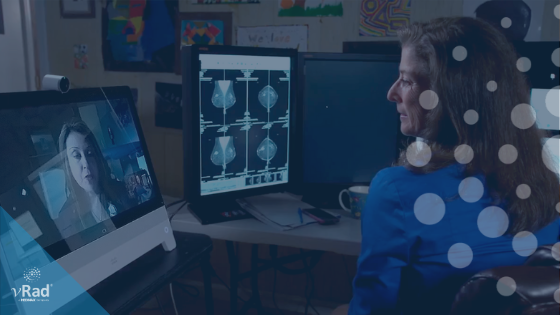Knowledge Is Power | BRCA Gene Testing for Breast Cancer
Genetic testing empowers women in the fight against breast cancer. One in eight women will develop breast cancer.

Remote radiologist jobs with flexible schedules, equitable pay, and the most advanced reading platform. Discover teleradiology at vRad.

Radiologist well-being matters. Explore how vRad takes action to prevent burnout with expert-led, confidential support through our partnership with VITAL WorkLife. Helping radiologists thrive.

Visit the vRad Blog for radiologist experiences at vRad, career resources, and more.

vRad provides radiology residents and fellows free radiology education resources for ABR boards, noon lectures, and CME.

Teleradiology services leader since 2001. See how vRad AI is helping deliver faster, higher-quality care for 50,000+ critical patients each year.

Subspecialist care for the women in your community. 48-hour screenings. 1-hour diagnostics. Comprehensive compliance and inspection support.

vRad’s stroke protocol auto-assigns stroke cases to the top of all available radiologists’ worklists, with requirements to be read next.

vRad’s unique teleradiology workflow for trauma studies delivers consistently fast turnaround times—even during periods of high volume.

vRad’s Operations Center is the central hub that ensures imaging studies and communications are handled efficiently and swiftly.

vRad is delivering faster radiology turnaround times for 40,000+ critical patients annually, using four unique strategies, including AI.
.jpg?width=1024&height=576&name=vRad-High-Quality-Patient-Care-1024x576%20(1).jpg)
vRad is developing and using AI to improve radiology quality assurance and reduce medical malpractice risk.

Now you can power your practice with the same fully integrated technology and support ecosystem we use. The vRad Platform.

Since developing and launching our first model in 2015, vRad has been at the forefront of AI in radiology.

Since 2010, vRad Radiology Education has provided high-quality radiology CME. Open to all radiologists, these 15-minute online modules are a convenient way to stay up to date on practical radiology topics.

Join vRad’s annual spring CME conference featuring top speakers and practical radiology topics.

vRad provides radiology residents and fellows free radiology education resources for ABR boards, noon lectures, and CME.

Academically oriented radiologists love practicing at vRad too. Check out the research published by vRad radiologists and team members.

Learn how vRad revolutionized radiology and has been at the forefront of innovation since 2001.

%20(2).jpg?width=1008&height=755&name=Copy%20of%20Mega%20Nav%20Images%202025%20(1008%20x%20755%20px)%20(2).jpg)

Visit the vRad blog for radiologist experiences at vRad, career resources, and more.


Explore our practice’s reading platform, breast imaging program, AI, and more. Plus, hear from vRad radiologists about what it’s like to practice at vRad.

Ready to be part of something meaningful? Explore team member careers at vRad.
1 min read
 Arlene Sussman, MD
:
May 17, 2023
Arlene Sussman, MD
:
May 17, 2023
.jpg)
On May 9, 2023, the U.S. Preventive Services Task Force (USPSTF) issued draft recommendations that average-risk women get screened for breast cancer every two years beginning at age 40.
While this is a step in the right direction, I have never wavered from the science that proved the life-saving benefits of annual screenings commencing at the age of 40. Here’s why.
The average time it takes for a cancer to double in size is approximately 90 days. If the smallest detectable cancer of around 0.3 centimeters goes unnoticed by the radiologist on a screening mammogram, it is much more likely to be seen a year later when it is larger but still less than 1 cm. in size. It is crucial to note that 1 cm. serves as a critical size differentiator. Once a tumor has grown beyond 1 cm., the likelihood of metastasis increases significantly. Breast cancers that are smaller than 1 cm. have an excellent long-term prognosis.
If a woman goes in for screening only once every two years, there is a higher chance that if cancer is present, it will be larger than 1 cm. at the time of detection. The negligible additional radiation associated with yearly screening is significantly outweighed by the numerous benefits of early detection.
I stand with organizations like the American College of Radiology and The Society for Breast Imaging in recommending ANNUAL screening mammograms for average-risk women beginning at age 40.

Genetic testing empowers women in the fight against breast cancer. One in eight women will develop breast cancer.

At the foundation of everything we do at vRad is the goal of helping our clients provide the highest level of patient care regardless of the time and...
.png)
Whoever said the only things certain in life are death and taxes never faced an MQSA inspection. Federally mandated in the early ’90s...
vRad (Virtual Radiologic) is a national radiology practice combining clinical excellence with cutting-edge technology development. Each year, we bring exceptional radiology care to millions of patients and empower healthcare providers with technology-driven solutions.
Non-Clinical Inquiries (Total Free):
800.737.0610
Outside U.S.:
011.1.952.595.1111
3600 Minnesota Drive, Suite 800
Edina, MN 55435